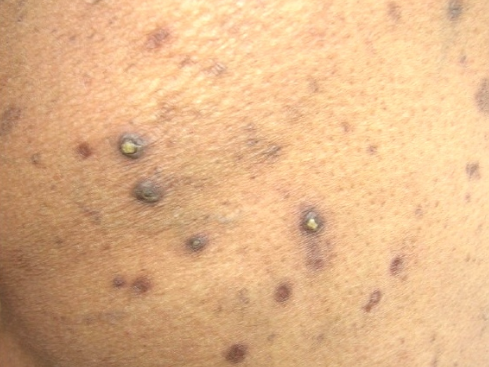Kyrle's disease (Hyperkeratosis follicularis et follicularis in cutem penetrans) is an acquired perforating dermatosis characterized by the presence of large keratotic papules. ICD-10 code is L87.0.
A rare disorder that is thought to be inherited as an autosomal recessive trait. The disease typically begins between the ages of 20 and 70, with an average onset in the 30s to 40s. Children are very rarely affected, and women tend to be more affected than men.
The pathogenesis is unknown. There have been cases where the disease developed during penicillamine treatment. Patients often have comorbidities such as diabetes and chronic renal insufficiency, less commonly liver failure, heart failure, hypothyroidism, and hyperlipoproteinemia.
The disease develops gradually and is characterized by the appearance of scattered firm papules with central keratinization resembling a plug, predominantly follicular and occasionally parafollicular. In some cases, these papules may be painful to palpation. The initial papules are often the same color as the surrounding skin and measure 2-3 mm in diameter, later gradually increasing to 8-10 mm. The color around the keratinized center is grayish, reddish-brown, or yellowish, with no inflammatory changes at the periphery. The keratinized masses may give the papules a verrucous appearance.
The eruption tends to grow peripherally and coalesce to form dry, verrucous, polycyclic plaques. Ichthyosiform skin changes are possible. After removal of the keratinized plug, slightly moist or slightly hemorrhagic, crater-like depressions are seen (Kyrle's phenomenon). The lesions are found predominantly on the extensor surfaces of the shins and forearms, buttocks, sometimes on the face, trunk, and scalp, and much less frequently on the palms and soles. Mucous membranes are not usually involved. Fresh eruptions may cause mild itching or may not bother the patient at all.
- Common warts
- Perforating folliculitis
- Nodular prurigo
- Multiple keratoacanthomas
- Pityriasis rubra pilaris
- Hypertrophic Lichen Planus
- Darier disease
- Porokeratosis of Mibelli
- Flegel disease
- Elastosis perforans serpiginosa
- Angiokeratomas
First-line therapy:
- Tretinoin 0.1% cream
- Broadband and narrowband UV therapy
Second-line therapy:
- Allopurinol
- PUVA therapy with psoralen
- Acitretin
Third-line therapy:
- 0.1% phenol with 10% glycerin
- Doxycycline
- Surgical treatment
- Percutaneous electrical nerve stimulation
- Topical corticosteroids
- Keratolytic agents (e.g., salicylic acid and urea)

